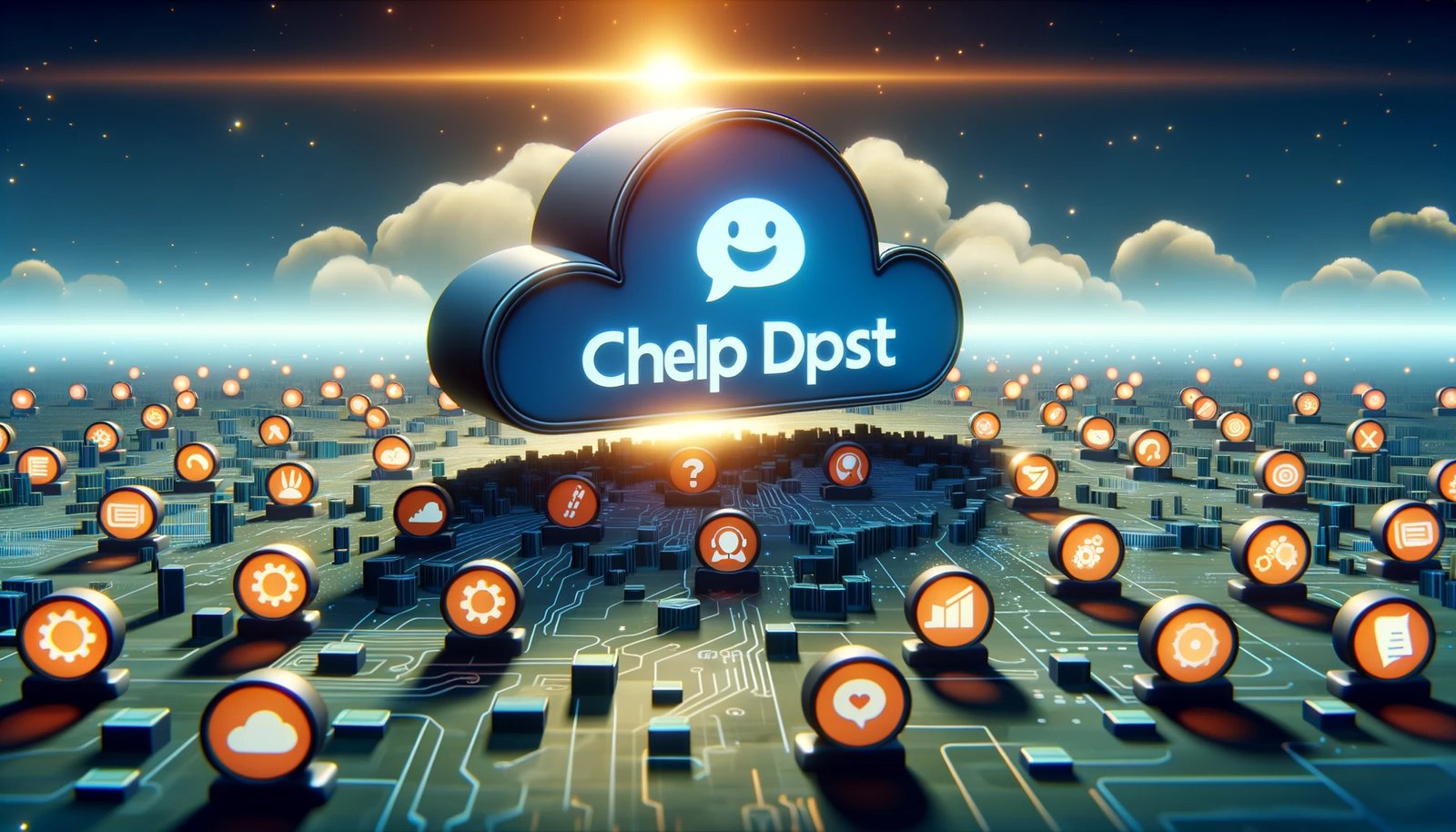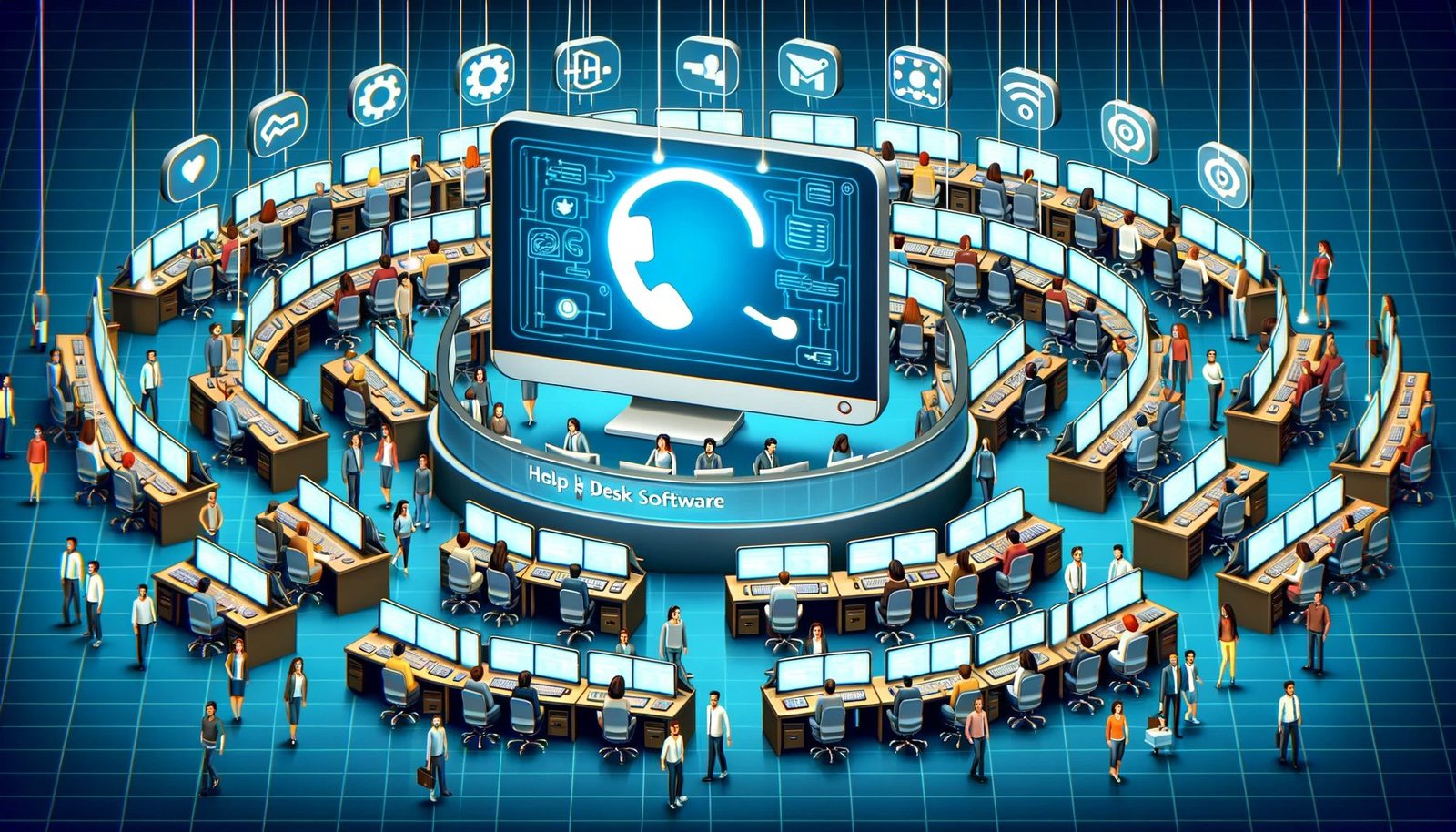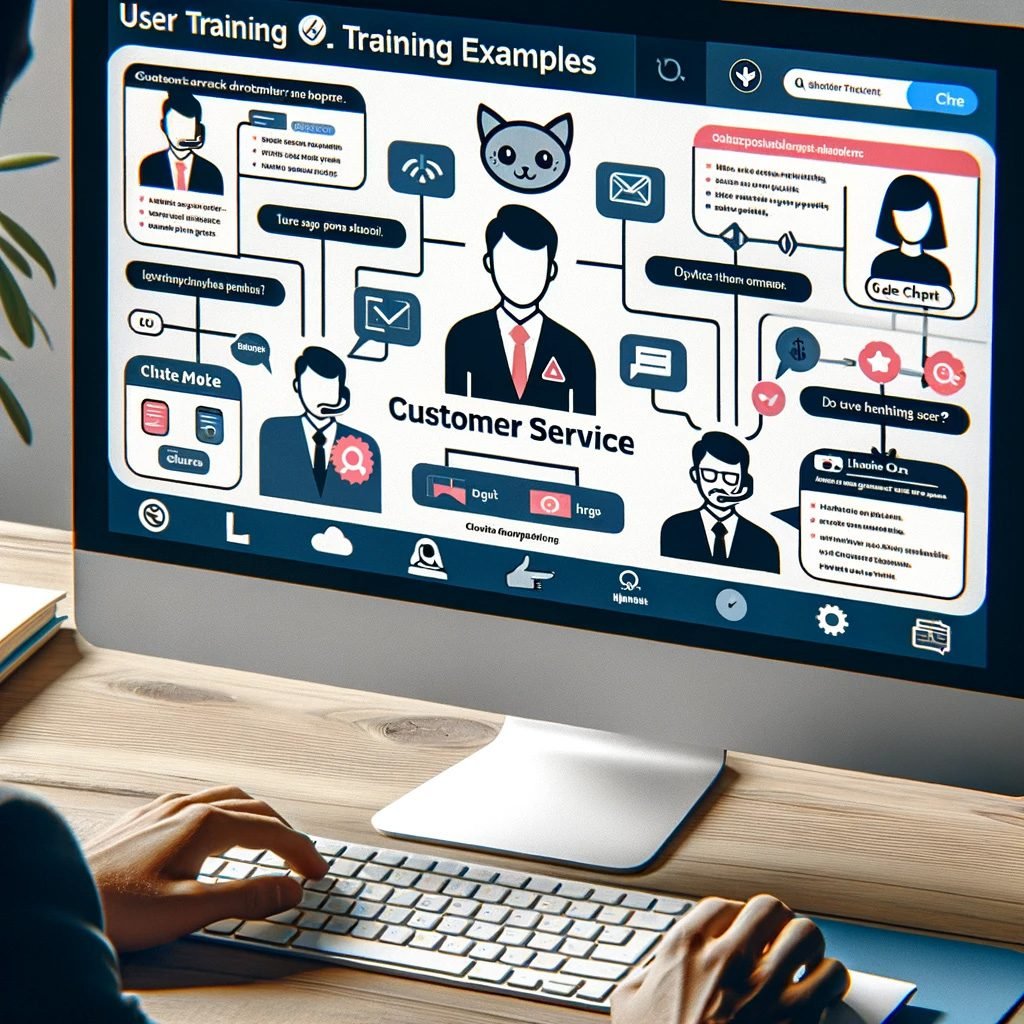Case Studies: How Businesses Have Improved Their Customer Support with Help Desk Software Alternatives to ChatGPT
Case Studies: How Businesses Have Improved Their Customer Support with Help Desk Software Alternatives to ChatGPT
Introduction – Customer Support with Help Desk Software Alternatives to ChatGPT
In today’s hyper-competitive business world, the significance of top-notch customer support cannot be overstated. As brands jostle for consumer attention, it’s the post-purchase experience that often determines loyalty, repeat business, and word-of-mouth recommendations.
The importance of effective customer support in today’s business landscape
In an era where consumers have a plethora of choices at their fingertips, businesses can no longer solely rely on the quality of their products or services. The entire customer journey, especially the post-purchase phase, plays a pivotal role in shaping perceptions and influencing decisions. Effective customer support isn’t just about resolving issues; it’s about fostering trust, building long-term relationships, and ensuring that customers feel valued at every touchpoint. With platforms like ChatGPT offering automated conversational solutions, the bar for customer interactions has been set high.
Setting the stage for exploring help desk software as an alternative to ChatGPT
While conversational AI platforms like ChatGPT have revolutionized customer interactions with their real-time response capabilities, they aren’t the be-all and end-all solution for businesses. There’s a growing realization of the need for more comprehensive, integrated tools that offer a holistic approach to customer support. This is where help desk software, a cornerstone of CRM solutions, comes into the picture. As we delve deeper, we’ll explore how these platforms can serve as robust alternatives to ChatGPT, offering functionalities that go beyond mere conversation.
Stay with us as we navigate through the world of help desk software, understanding its significance and how it can redefine the way businesses approach customer support in the digital age.
The Role of ChatGPT in Customer Support
In the vast realm of AI-driven customer support tools, ChatGPT has emerged as a notable contender. Its advanced conversational capabilities have made it a go-to for many businesses aiming to enhance their customer interactions.
A brief overview of ChatGPT and its capabilities
ChatGPT, a product of OpenAI, is renowned for its natural language processing prowess. It’s not just a chatbot; it’s a sophisticated AI model that can understand context, answer queries, and even engage in meaningful conversations. This has made it an attractive tool for businesses looking to automate their customer support without compromising on the quality of interactions. With the ability to be trained for specific industries or niches, ChatGPT offers a tailored experience, making customer interactions more personalized and efficient.
How businesses have been using ChatGPT for customer interactions
Many businesses, from e-commerce platforms to WordPress web development services, have integrated ChatGPT into their customer support frameworks. The primary allure is its 24/7 availability, ensuring that customers from different time zones always have a point of contact. Moreover, its ability to handle multiple queries simultaneously reduces wait times, enhancing overall customer satisfaction. While ChatGPT is a powerful tool, the evolving needs of businesses and the diverse challenges of customer relationship management have led many to explore additional help desk software and CRM solutions.

The Need for Comprehensive Help Desk Solutions
In an era where customer expectations are continually evolving, businesses are under constant pressure to deliver unparalleled support experiences. While conversational AI tools like ChatGPT have revolutionized the initial interaction phase, there’s a growing realization that customer support is a multifaceted domain requiring more comprehensive solutions.
The limitations of relying solely on conversational AI like ChatGPT
ChatGPT, with its advanced conversational capabilities, offers a seamless way to engage with customers in real time. However, customer support isn’t just about answering queries. It encompasses tracking issues, managing tickets, following up, and ensuring that every concern is addressed promptly. Relying solely on AI can sometimes lead to gaps in these areas. For instance, while ChatGPT can provide instant answers, it might not be adept at handling complex multi-stage issues that require human intervention or tracking long-term customer concerns. Moreover, businesses that use platforms like Shopify for e-commerce might need specialized tools to integrate customer support with order management and other backend processes.
The multifaceted nature of customer support and management
Customer support goes beyond just answering questions. It’s about building relationships, understanding customer needs, and ensuring that they have a seamless experience at every touchpoint. This involves managing feedback, handling returns or complaints, and even proactive outreach to gauge customer satisfaction. Tools specialized in CRM, like Salesforce, offer features that address these diverse needs, from ticketing systems to customer journey mapping. In essence, while conversational AI forms a crucial part of the support ecosystem, a holistic approach necessitates the integration of comprehensive help desk solutions.
Help Desk Software Alternative 1: Zendesk
Zendesk, a name synonymous with top-tier customer support solutions, has carved a niche for itself in the realm of help desk software. With businesses spanning various sectors, from WordPress web development services to e-commerce platforms, turning to Zendesk for their customer support needs, it’s evident that this platform offers something truly special.
Overview and standout features of Zendesk
Zendesk is a cloud-based help desk solution designed to improve customer relationships through efficient and effective support. Some of its standout features include:
- Multi-channel support: Whether it’s email, chat, phone, or even social media, Zendesk ensures that businesses can reach their customers wherever they are.
- Knowledge Base: An integrated self-service platform where customers can find answers without reaching out to support, reducing the workload on support teams.
- Automation and AI: With tools like Answer Bot, Zendesk leverages AI to provide instant answers to customer queries, seamlessly integrating with platforms like Shopify for e-commerce.
- Customization: From branding the support portal to creating custom workflows, Zendesk offers a plethora of customization options.
- Reporting and Analytics: In-depth insights into support performance, customer satisfaction, and areas of improvement.
How Zendesk offers a holistic approach to customer support
While conversational AI tools like ChatGPT excel in real-time interactions, Zendesk’s strength lies in its comprehensive approach. It not only addresses immediate customer concerns but also anticipates future issues, offering solutions even before they arise. For instance, its knowledge base empowers customers to find solutions on their own, fostering a sense of independence and satisfaction.
Moreover, with its robust integration capabilities, businesses can seamlessly connect Zendesk with other tools, be it CRM systems or e-commerce platforms like Shopify. This ensures that support teams have all the information they need at their fingertips, from customer purchase histories to previous interactions, enabling them to provide personalized and informed support.
In essence, Zendesk goes beyond just resolving tickets. It focuses on building and nurturing long-term customer relationships, making it a preferred choice for businesses aiming for not just customer satisfaction but customer delight.
Help Desk Software Alternative 2: Freshdesk
Freshdesk, a product of Freshworks, has rapidly emerged as a formidable player in the help desk software arena. With its intuitive interface, robust feature set, and emphasis on multi-channel support, Freshdesk has garnered the attention of businesses across various sectors, including those in the WordPress web development domain.
Introduction to Freshdesk’s capabilities
At its core, Freshdesk is designed to streamline customer support operations, making it easier for businesses to manage, track, and resolve customer queries. Some of its notable capabilities include:
- Ticketing System: Efficiently categorize, prioritize, and assign tickets to ensure timely resolution.
- Collaboration Tools: Enables support teams to collaborate in real-time, ensuring that complex issues are addressed promptly.
- Automation: From auto-assigning tickets based on workload to sending follow-up emails, Freshdesk’s automation tools reduce manual tasks and enhance efficiency.
- Self-service Portals: Integrated knowledge bases and forums allow customers to find solutions on their own, reducing the dependency on support teams.
- Omnichannel Support: Whether it’s email, chat, phone, or social media, Freshdesk ensures a consistent support experience across all channels.
Benefits for businesses aiming to offer multi-channel support
In today’s digital age, customers expect support across various channels, be it a quick chat query or a detailed email. Freshdesk’s emphasis on omnichannel support ensures that businesses can meet these expectations seamlessly. Here’s how:
- Consistent Experience: Regardless of the channel, customers receive a consistent level of support, ensuring brand consistency.
- Centralized Dashboard: All customer interactions, whether from social media or email, are centralized, ensuring that support agents have a holistic view of the customer’s journey.
- Integrated Tools: Freshdesk’s integrations with platforms like Shopify ensure that support teams have all the necessary information, from order details to customer preferences, at their disposal.
- Data-Driven Insights: Multi-channel support means a wealth of data. Freshdesk’s analytics tools provide insights into channel performance, agent efficiency, and customer satisfaction, guiding businesses in their support strategies.
Freshdesk, with its multi-channel capabilities, ensures that businesses are not just reactive but proactive in their support efforts. By offering a unified support experience across channels and leveraging data for continuous improvement, Freshdesk positions itself as a must-have tool for businesses serious about customer satisfaction.
Help Desk Software Alternative 3: Intercom
Intercom, with its modern approach to customer support, has revolutionized the way businesses interact with their customers in real time. Recognized for its chat-centric interface and powerful integrative tools, Intercom has become a favorite among businesses, including those in the WordPress web development sector, aiming to provide instantaneous support.
Key features and functionalities of Intercom
- Real-time Messaging: At the heart of Intercom is its real-time chat functionality, allowing businesses to engage with customers instantly, leading to faster issue resolution.
- Customizable Chatbots: Intercom’s bots can qualify leads, answer common questions, and route conversations to the right team, ensuring 24/7 support.
- Segmentation and Targeting: Businesses can send targeted messages based on user behavior, location, and more, enhancing engagement.
- Integrated Help Center: Customers can access articles and FAQs directly from the chat, reducing the need for human intervention for common queries.
- Team Collaboration: Support agents can collaborate behind the scenes with notes, mentions, and assignment features, ensuring a unified response to customer queries.
- Performance Analytics: Intercom provides detailed insights into conversation volumes, response times, and resolution rates, helping businesses optimize their support strategy.
The advantage of Intercom’s integrative tools for real-time support
Intercom stands out not just for its chat capabilities but also for its integrative approach to real-time support:
- Unified Customer Profiles: Intercom consolidates customer data from various touchpoints, giving support agents a 360-degree view of the customer, from browsing history to past interactions.
- App Integrations: With integrations spanning CRM systems, marketing software, and even e-commerce platforms like Shopify, Intercom ensures that support agents have all relevant data at their fingertips.
- Automated Workflows: By integrating with tools like Slack or Jira, Intercom can automate workflows, like notifying teams about high-priority issues or creating tickets for follow-up.
- Real-time Product Tours: Intercom’s product tours guide users through new features or processes in real time, reducing the need for support interactions.
In essence, Intercom’s integrative tools ensure that real-time support is not just about speed but also about context. By providing support agents with comprehensive customer insights and seamless tool integrations, Intercom ensures that real-time support is also relevant, personalized, and efficient.
Help Desk Software Alternative 4: Kayako
In the realm of customer service platforms, Kayako has emerged as a formidable player, offering businesses a unified platform to manage, monitor, and maintain customer interactions. With its roots dating back to the early 2000s, Kayako has evolved from a simple helpdesk solution to a comprehensive customer service platform catering to businesses of all sizes, including those venturing into WordPress web development for agencies.
Exploring Kayako’s unified customer service platform
- Omni-channel Support: Kayako allows businesses to offer support across multiple channels, including email, chat, social media, and phone, all from a single dashboard.
- Unified Customer Journey: Every interaction, from a chat conversation to a support ticket or a phone call, is tracked and unified under a single customer profile, ensuring agents have a holistic view of the customer’s journey.
- Automation and Workflows: Kayako’s automation tools ensure that tasks like ticket assignments, follow-ups, and notifications are handled seamlessly, reducing manual intervention.
- Knowledge Base Integration: Businesses can create and integrate a comprehensive knowledge base, allowing customers to find answers to common queries without reaching out to support.
- Collaboration Tools: Agents can collaborate in real-time, share notes, and escalate issues, ensuring that customers receive consistent and efficient support.
How Kayako streamlines customer interactions and queries
- Smart Search: Kayako’s search functionality allows agents to quickly find customer profiles, past interactions, and relevant knowledge base articles, speeding up resolution times.
- Custom Views and Macros: Agents can customize their dashboard views based on their preferences and use macros to perform repetitive tasks with a single click.
- Performance Analytics: Kayako provides in-depth insights into metrics like first response time, customer satisfaction, and ticket volume, helping businesses optimize their support strategy.
- Integration Capabilities: Kayako seamlessly integrates with tools like Shopify, CRM systems, and marketing platforms, ensuring that support agents have all the information they need.
- Self-service Portals: Customers can log in to their dedicated portals to track their support tickets and chat history and access the knowledge base, promoting self-service.
Kayako’s emphasis on unifying customer interactions and streamlining queries ensures that businesses can offer efficient, consistent, and personalized support. Whether it’s a startup or a large enterprise, Kayako’s platform is equipped to handle the diverse and evolving needs of modern customer support.

Help Desk Software Alternative 5: Groove
In the bustling world of customer support platforms, Groove has carved a niche for itself by offering a simplified yet powerful customer support platform. Designed with the needs of small to medium-sized businesses in mind, Groove’s ethos revolves around streamlining support workflows without overwhelming users with unnecessary complexities. This approach has made it a favorite among businesses, especially those venturing into WordPress web development for small businesses.
A look into Groove’s simplified customer support platform
- Unified Inbox: Groove’s shared inbox ensures that no customer query goes unnoticed. Whether it’s an email, chat, or social media message, everything lands in one place, making it easier for teams to manage and respond.
- Knowledge Base Integration: Groove allows businesses to set up a robust knowledge base, empowering customers to find answers on their own, thereby reducing the number of support tickets.
- Collaboration Features: With notes, mentions, and private comments, teams can collaborate seamlessly behind the scenes to ensure customers get the best possible support.
- Automation and Rules: Groove’s automation tools help in categorizing, tagging, and assigning tickets based on predefined rules, ensuring that the right team or agent handles the right query.
- Reporting and Analytics: With Groove’s detailed reports, businesses can gain insights into metrics like response time, resolution time, and customer satisfaction, helping them make informed decisions.
The potential for businesses to optimize their support workflows
- Customizable Support Widgets: Groove’s widgets can be customized to match a brand’s aesthetics and can be embedded on websites, offering customers an easy way to reach out.
- Integrations: Groove integrates seamlessly with popular tools and platforms, including Shopify E-commerce Website Development, ensuring that support agents have all the relevant information at their fingertips.
- Feedback and Feature Requests: Groove’s platform allows customers to submit feedback and feature requests, helping businesses understand their customers’ needs and priorities.
- Simplified User Interface: Groove’s user-friendly interface ensures that agents, even those new to customer support, can get started without a steep learning curve.
- Continuous Improvements: Groove is known for its proactive approach to incorporating user feedback, ensuring that the platform is always evolving and improving.
In essence, Groove’s focus on simplicity, combined with its powerful features, ensures that businesses can offer top-notch support without getting bogged down by complexities. Whether a business is just starting out or is looking to optimize its support workflows, Groove offers a solution that’s both effective and easy to use.
Comparative Analysis: ChatGPT vs. Help Desk Software Alternatives
In the realm of customer support, both conversational AI platforms like ChatGPT and comprehensive help desk software have their unique offerings. While ChatGPT excels in real-time interactions and simulating human-like conversations, help desk software alternatives provide a more holistic approach to customer support management. Let’s delve deeper into the strengths, weaknesses, and suitability of each platform for various business sizes and industries.
Strengths and weaknesses of each platform
ChatGPT:
Strengths:
- Real-time Interactions: ChatGPT offers instant responses, ensuring customers don’t have to wait.
- Scalability: Can handle a large volume of queries simultaneously without any human intervention.
- Cost-Effective: Reduces the need for a large customer support team, especially for basic queries.
- Personalized Conversations: With the right training data, ChatGPT can offer personalized responses based on customer history.
Weaknesses:
- Limited to Conversations: Cannot manage tickets, track customer history, or integrate with other business tools as seamlessly as dedicated help desk software.
- Potential Misunderstandings: AI might not always grasp the nuances of human language, leading to potential misinterpretations.
Help Desk Software (e.g., Zendesk, Freshdesk, Intercom):
Strengths:
- Comprehensive Support Management: From ticketing to knowledge bases, help desk software offers a 360-degree view of customer support.
- Collaboration: Allows multiple agents to collaborate on a single ticket, ensuring complex issues are resolved efficiently.
- Integration Capabilities: Seamless connectivity with other business tools, including CRM solutions.
- Data-Driven Insights: Detailed analytics and reporting help businesses understand customer behavior and improve support strategies.
Weaknesses:
- Cost: Some platforms can be expensive, especially for small businesses.
- Learning Curve: This might require training for agents, especially on more complex platforms.
Suitability for different business sizes and industries
- Startups and Small Businesses: For businesses with limited resources, ChatGPT can be a cost-effective solution for handling basic customer queries. However, as they grow, integrating help desk software might become essential for managing increasing customer interactions.
- Mid-sized Businesses: A combination of both might work best. ChatGPT can handle initial interactions and frequently asked questions, while help desk software can manage more complex queries and support tickets.
- Large Enterprises: Given the volume and complexity of customer interactions, comprehensive help desk software is almost a necessity. ChatGPT can still play a role in offering instant responses and reducing the load on customer support agents.
- E-commerce Platforms: With the rise of Shopify E-commerce Website Development and similar platforms, instant chat support via ChatGPT can enhance the shopping experience. However, for post-purchase support, ticketing systems provided by help desk software are invaluable.
- Tech and SaaS Companies: Given the technical nature of queries, a robust help desk platform is essential. ChatGPT can assist in guiding users to relevant knowledge base articles or troubleshooting steps.
While ChatGPT offers a revolutionary approach to customer interactions, help desk software alternatives provide the comprehensive tools businesses need to manage and optimize their customer support. The choice between them—or a combination of both—largely depends on the specific needs and size of the business.
Case Studies: Businesses Excelling with Help Desk Software
In the dynamic world of customer support, businesses are constantly seeking tools that can enhance their customer relationships and streamline their operations. Help desk software has emerged as a game-changer for many companies. Let’s explore some real-world success stories of businesses that have harnessed the power of these platforms.
a. Company A’s Success with Zendesk: Overcoming challenges and results achieved
Background: Company A, a leading e-commerce platform specializing in Shopify E-commerce Website Development, faced challenges in managing the increasing volume of customer queries as they expanded their product range.
Challenges:
- Inefficient ticket management leads to delayed responses.
- Lack of a centralized system to track customer interactions.
Solution: After integrating Zendesk, Company A was able to:
- Categorize and prioritize tickets efficiently.
- Use data-driven insights to identify common issues and create a comprehensive FAQ section.
Results:
- A 40% reduction in response time.
- A 25% increase in customer satisfaction scores.
b. Company B’s Transformation with Freshdesk: Strategies implemented and outcomes
Background: Company B, a startup offering WordPress web development services, struggled with coordinating its small customer support team.
Challenges:
- Overlapping responses from multiple agents.
- Lack of clarity on customer history.
Solution: With Freshdesk, Company B:
- Implemented a collaborative ticketing system.
- Created a centralized customer database.
Results:
- A 50% reduction in ticket resolution time.
- Improved team collaboration, leading to a 30% increase in first-call resolution.
c. Company C’s Growth with Intercom: The journey and key takeaways
Background: Company C, a SaaS provider, wanted to enhance its real-time support for its global clientele.
Challenges:
- Time zone differences lead to support delays.
- Inability to offer instant solutions to technical queries.
Solution: By leveraging Intercom, Company C:
- Introduced 24/7 chat support.
- Integrated AI-powered chatbots for instant troubleshooting.
Results:
- A 60% increase in global customer engagement.
- A 35% reduction in support costs with automated solutions.
d. Company D’s Efficiency Boost with Kayako: Changes made and results observed
Background: Company D, a travel agency, faced challenges in managing queries from multiple channels, including email, chat, and social media.
Challenges:
- Fragmented customer communication.
- Missed opportunities due to delayed responses.
Solution: With Kayako, Company D:
- Unified all customer communication channels.
- Introduced automated follow-ups for booking inquiries.
Results:
- A 45% increase in bookings due to timely follow-ups.
- Enhanced customer experience with a 360-degree view of all interactions.
e. Company E’s Customer Satisfaction Spike with Groove: Tactics and Feedback
Background: Company E, a content SEO agency, aimed to improve its client communication and project update process.
Challenges:
- Delayed project updates lead to client dissatisfaction.
- Lack of transparency in the project management process.
Solution: After adopting Groove, Company E:
- Introduced a client portal for real-time project tracking.
- Automated project update emails.
Results:
- A 50% increase in client retention rates.
- Positive feedback on transparency and communication improvements.
These case studies highlight the transformative potential of help desk software for businesses across various sectors. By addressing specific challenges and optimizing customer interactions, companies can achieve remarkable results and foster lasting customer relationships.
Key Benefits of Transitioning to Help Desk Software
In the digital age, where customer expectations are constantly evolving, businesses need to be agile and responsive. Transitioning to help desk software can offer a plethora of advantages, ensuring that companies not only meet but exceed these expectations. Let’s delve into the key benefits of making this strategic move.
Enhanced customer satisfaction and loyalty
Understanding the Customer: With tools like CRM solutions, help desk software provides a 360-degree view of the customer, capturing their interactions, preferences, and feedback. This holistic understanding allows businesses to tailor their responses and services, ensuring each customer feels valued and understood.
Consistent Support: Whether it’s a query about WordPress web development services or a technical glitch on an e-commerce platform, help desk software ensures that every issue is addressed promptly and consistently. This reliability fosters trust and loyalty among customers.
Streamlined workflows and reduced response times
Automated Ticketing: Gone are the days of manually sorting through customer emails. Help desk software automatically categorizes and prioritizes incoming queries, ensuring that urgent issues are addressed first.
Collaborative Solutions: Features like shared inboxes and real-time collaboration tools mean that teams can work together seamlessly, reducing bottlenecks and ensuring faster resolution times. For instance, a query about Shopify E-commerce Website Development can be instantly routed to the right expert, ensuring a swift and accurate response.
Comprehensive data analytics and insights
Data-Driven Decisions: Help desk software captures a wealth of data, from customer interaction times to common query themes. This data can be analyzed to glean insights, helping businesses refine their support strategies and identify areas for improvement.
Feedback Loop: With integrated survey tools and feedback mechanisms, businesses can continuously gather customer opinions. Whether it’s positive feedback about a content SEO strategy or constructive criticism about a product feature, this feedback is invaluable in driving continuous improvement.
Transitioning to help desk software is not just about adopting a new tool; it’s about embracing a customer-centric approach. By streamlining operations, offering consistent support, and harnessing the power of data, businesses can elevate their customer support game, ensuring lasting relationships and sustained growth.
Making the Switch: Transitioning from ChatGPT to Help Desk Software
In today’s fast-paced digital landscape, businesses are constantly seeking tools that can enhance their customer support capabilities. While conversational AIs like ChatGPT have revolutionized real-time interactions, there’s a growing need for more comprehensive solutions. Enter Help Desk Software – a holistic platform designed to manage, streamline, and optimize customer support operations. If you’re contemplating this transition, here’s a guide to ensure a seamless shift.
Steps and considerations for businesses looking to make the change
1. Assess Your Current Setup: Before diving into a new system, take stock of your existing customer support processes. Understand the strengths and limitations of using ChatGPT. For instance, while ChatGPT might excel in handling WordPress web development queries, it might fall short in managing complex multi-step support tickets.
2. Define Your Objectives: What do you aim to achieve with the new help desk software? Whether it’s faster response times, better ticket tracking, or enhanced CRM solutions, having clear objectives will guide your selection process.
3. Choose the Right Software: Not all help desk solutions are created equal. Some might be tailored for e-commerce businesses, while others might be geared towards service providers like Rizve Joarder UI and UX Services. Research, take demos, and choose a platform that aligns with your business needs.
4. Data Migration: Transitioning means moving your existing customer data, support tickets, and other relevant information to the new system. Ensure the help desk software you choose supports easy data import from ChatGPT or other platforms you use.
5. Training: Your team needs to be comfortable with the new platform. Organize training sessions, webinars, or workshops to familiarize them with the software’s features and functionalities.
Tips for a smooth transition and integration
1. Pilot Testing: Before a full-scale rollout, conduct a pilot test. Choose a small team or department to use the help desk software, gather feedback, and make necessary adjustments.
2. Integrate with Other Tools: Help desk software becomes even more powerful when integrated with other business tools, be it e-commerce SEO tools or marketing platforms. Ensure seamless integrations to enhance efficiency.
3. Communicate with Customers: Let your customers know about the change. Assure them that this transition is aimed at serving them better. You could even invite them to provide feedback on the new support experience.
4. Monitor and Optimize: Transitioning doesn’t end with implementation. Continuously monitor the software’s performance, gather feedback, and make iterative improvements.
While ChatGPT offers a dynamic conversational interface, transitioning to help desk software equips businesses with a more comprehensive toolset to manage and enhance customer support. With careful planning, clear objectives, and a focus on continuous improvement, businesses can ensure a smooth transition, setting the stage for superior customer experiences.
The Future of Customer Support Tools
In an era where customer experience is paramount, businesses are constantly on the lookout for tools and technologies that can elevate their support game. Both help desk software and conversational AI, like ChatGPT, have made significant strides in recent years. But as we gaze into the future, what can we expect from these platforms? Let’s delve into some predictions and trends that might shape the landscape of customer support tools.
Predictions and trends for help desk software and conversational AI
1. AI-Powered Predictive Support: With advancements in machine learning, future help desk software might be able to predict issues before they arise. Using data analytics, businesses could proactively address potential problems, enhancing customer satisfaction.
2. Omnichannel Support: The lines between different support channels (email, chat, social media) will blur. Help desk platforms will offer seamless integration across all channels, ensuring consistent and unified customer experiences.
3. Enhanced Personalization: Conversational AI will become smarter, offering more personalized interactions based on user behavior, past interactions, and preferences. Imagine a ChatGPT variant that can recall a customer’s past purchases or preferences, offering tailored support instantly.
4. Voice-Activated Support: With the rise of voice assistants like Alexa and Google Assistant, voice-activated customer support might become a standard feature in help desk software, allowing users to resolve queries hands-free.
5. Augmented Reality (AR) in Support: AR could revolutionize product-based support. Customers could use their phone cameras to show the issue, and the support tool, using AR, could guide them visually to resolve it.
6. Self-Service and Knowledge Bases: Powered by AI, knowledge bases will become more dynamic. They’ll offer solutions in real time, updating themselves based on new issues and resolutions.
7. Integration with CRM Solutions: A deeper integration between help desk software and CRM platforms will ensure that every customer interaction, be it a sale or a support ticket, is captured and used to enhance the overall customer journey.
How businesses can stay ahead of the curve
1. Continuous Learning: The world of customer support is evolving rapidly. Businesses should invest in regular training sessions, workshops, and courses to ensure their teams are updated with the latest trends and tools.
2. Feedback Loop: Encourage customers to provide feedback on their support experience. This feedback is invaluable in refining and optimizing support strategies.
3. Explore and Experiment: Don’t shy away from trying out new tools or features. Be it a new module in your help desk software or a novel capability in conversational AI, experimentation can lead to innovation.
4. Stay Updated with Industry News: Join forums, subscribe to newsletters, and follow industry leaders. Staying updated with the latest in customer support will give businesses a competitive edge.
5. Collaborate with Experts: Consider collaborating with industry experts, like those offering WordPress web development services, to ensure your support tools are optimized for your specific business needs.
The future of customer support tools is bright, with a plethora of innovations on the horizon. By staying informed, adaptable, and customer-centric, businesses can harness these advancements to offer unparalleled support experiences, fostering loyalty and trust among their clientele.
Conclusion
In today’s fast-paced digital landscape, the importance of effective customer support cannot be overstated. As the bridge between businesses and their clientele, the tools and platforms chosen for this pivotal role-play a significant part in shaping the overall customer experience. While conversational AI platforms like ChatGPT have revolutionized real-time interactions, the multifaceted nature of customer support demands a more holistic approach. This is where comprehensive help desk software solutions come into play.
From the intuitive interface of Zendesk to the multi-channel capabilities of Freshdesk, from the real-time prowess of Intercom to the unified platform of Kayako, and the streamlined workflows of Groove – each offers a unique set of features tailored to address specific business needs. These platforms, backed by robust technology and innovative features, ensure that businesses are not just reacting to customer queries but proactively enhancing the customer journey.
However, the key lies in understanding one’s unique business requirements, customer expectations, and the challenges faced in the support domain. No single tool is a one-size-fits-all solution. Businesses must delve deep, explore these platforms, perhaps even integrate a few, and then decide on the one that aligns best with their vision for customer support.
In the realm of customer service, the right tools can be the difference between a satisfied customer and a lost opportunity. As the world of technology continues to evolve, businesses must stay agile, informed, and ready to adapt. So, take the plunge, explore these help desk software alternatives to ChatGPT, and find the perfect ally in your quest for customer service excellence. Your customers and your bottom line will thank you for it.
We’ve delved deep into the world of customer support tools, exploring the capabilities of ChatGPT and its robust help desk software alternatives. But the conversation doesn’t end here. We want to hear from you!
- Share Your Experiences: Have you used any of these platforms? What was your experience like? Did it transform your customer support game? We’re eager to hear your stories.
- Join the Discussion: What do you envision for the future of customer support tools? With the rapid advancements in technology, where do you see this domain heading in the next few years?
- Feedback is Gold: Your insights and feedback help us shape our content. If there’s a particular tool you’d like us to explore further or a topic you’re curious about, let us know.
Engage with us in the comments below, or reach out on our social media channels. Let’s keep this conversation going and, together, navigate the exciting world of customer support tools. Your insights could be the beacon for many others on a similar journey. Let’s collaborate, share, and learn together!
- Why are businesses considering help desk software alternatives to ChatGPT for customer support?
- While ChatGPT excels in conversational AI, some businesses require specialized help desk features like ticketing, knowledge bases, and multi-channel support.
- Which help desk software alternatives have businesses successfully transitioned to?
- Popular alternatives include Zendesk, Freshdesk, and ServiceNow, each offering a unique set of features tailored to different business needs.
- Can you provide an example of a business that significantly reduced its response time using a help desk alternative?
- [Insert a brief case study or reference] showcased how transitioning to [Help Desk Software] led to a 40% reduction in response time, enhancing customer satisfaction.
- How have help desk software alternatives helped businesses in managing high ticket volumes?
- With features like automated ticket routing, prioritization, and escalation, businesses have reported more efficient ticket resolution and reduced backlog.
- Are there case studies showcasing improved customer satisfaction scores after transitioning from ChatGPT to a help desk alternative?
- Yes, [Company X] reported a 20% increase in their CSAT scores within six months of implementing [Help Desk Software].
- How do help desk software alternatives integrate AI functionalities similar to ChatGPT?
- Many help desk platforms now incorporate AI-driven chatbots, predictive analytics, and automated workflows to provide instant support and streamline processes.
- Can businesses integrate ChatGPT into these help desk software alternatives for a combined solution?
- Absolutely. Many help desk platforms offer API integrations, allowing businesses to incorporate ChatGPT or other chatbot solutions seamlessly.
- How have businesses benefited from the multi-channel support offered by help desk software alternatives?
- Case studies have shown that businesses can offer consistent support across emails, social media, live chats, and phone calls, leading to a unified customer experience.
- What cost benefits have businesses experienced after transitioning to a help desk software alternative?
- While there’s an initial investment, businesses have reported reduced overheads, fewer support staff requirements, and increased customer retention, leading to a positive ROI.
- How do help desk software alternatives support businesses in analyzing customer feedback and improving support strategies?
- Through in-built analytics, sentiment analysis, and feedback collection tools, businesses can gain insights into customer pain points and continuously refine their support strategies.











